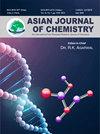Novel Benzimidazole based Hydrazide-hydrazone Compounds: Synthesis, Characterization and Antimicrobial Assessment
Q4 Chemistry
引用次数: 0
Abstract
This work presents a comprehensive study on the design, synthesis, spectral characterization and antimicrobial assessment of new hydrazide-hydrazone incorporated benzimidazole compounds (6a-p). The synthesis of these compounds (6a-p) involved the condensation of benzimidazole derivative, 4-(1-methyl-5-nitro-1H-benzo[d]imidazol-2-yl)butane hydrazide with substituted aromatic aldehydes, utilizing an efficient and environmentally benign synthetic route. The IR, NMR and mass spectrometry were among the spectroscopic methods used to characterize the novel synthesized substances to confirm their chemical structures. The antimicrobial properties of the synthesized benzimidazole-based hydrazide-hydrazone compounds (6a-p) were systematically assessed against a panel of pathogenic microorganisms, including two Gram-positive and two Gram-negative bacteria and three fungi. The potency of antimicrobial drugs was assessed by determining their minimum inhibitory concentrations (MIC). The findings demonstrate that compounds 6k and 6p have moderated antibacterial action against positive-Gram bacteria S. pyogenus (MTCC 442) and S. aureus (MTCC 96), but considerable antimicrobial activity against Gram-negative bacteria E. coli (MTCC 443) and P. aeruginosa (MTCC 1688). Although every drug exhibits mild to moderate antifungal efficacy against A. niger (MTCC 282), A. clavatus (MTCC 1323) and C. albicans (MTCC 227). Furthermore, in silico prediction of compounds pharmacokinetic properties was also conducted.基于苯并咪唑的新型肼基化合物:合成、表征和抗菌评估
这项工作全面研究了新的肼-腙结合苯并咪唑化合物(6a-p)的设计、合成、光谱表征和抗菌评估。这些化合物(6a-p)的合成涉及苯并咪唑衍生物、4-(1-甲基-5-硝基-1H-苯并[d]咪唑-2-基)丁烷酰肼与取代的芳香醛的缩合,采用的是高效、环保的合成路线。红外光谱、核磁共振和质谱是表征新型合成物质的光谱方法,以确认其化学结构。对合成的苯并咪唑类酰肼化合物(6a-p)的抗菌性能进行了系统评估,这些化合物针对的病原微生物包括两种革兰氏阳性菌、两种革兰氏阴性菌和三种真菌。通过测定最低抑菌浓度(MIC)来评估抗菌药物的效力。研究结果表明,化合物 6k 和 6p 对阳性革兰氏细菌化脓性链球菌(MTCC 442)和金黄色葡萄球菌(MTCC 96)具有中度抗菌作用,但对革兰氏阴性细菌大肠杆菌(MTCC 443)和绿脓杆菌(MTCC 1688)具有相当强的抗菌活性。虽然每种药物都对 A. niger(MTCC 282)、A. clavatus(MTCC 1323)和 C. albicans(MTCC 227)具有轻度到中度的抗真菌功效。此外,还对化合物的药代动力学特性进行了硅学预测。
本文章由计算机程序翻译,如有差异,请以英文原文为准。
求助全文
约1分钟内获得全文
求助全文
来源期刊

Asian Journal of Chemistry
化学-化学综合
CiteScore
0.80
自引率
0.00%
发文量
229
审稿时长
4 months
期刊介绍:
Information not localized
 求助内容:
求助内容: 应助结果提醒方式:
应助结果提醒方式:


